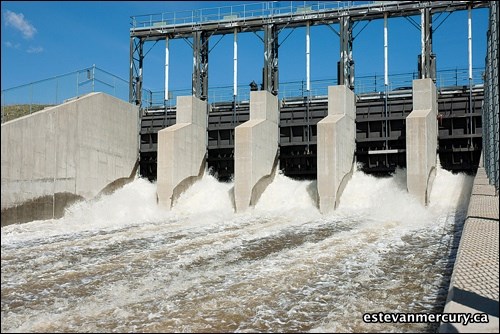There has been a near zero flow from Rafferty Dam reservoir the past two weeks, but it was for a good reason.
Dale Hjertaas, executive director of policy and communications for the Saskatchewan Watershed Authority, said the gates were closed to allow waters downstream to flow back into the river system. At the same time, biologists were netting and replacing fish back into the river stream while breaches in dikes and other infrastructure items throughout the downstream systems were being repaired without having to worry about a fresh infusion of water.
"The wetlands were being repaired and the fish that had been trapped in them are pretty well back into the river now, so the Rafferty and Alameda Dams will be back to a released flow of two or three cubic metres per second very soon, and that will continue on that pace throughout the winter," Hjertaas said.
Last year, as everyone knows, the levels were lowered significantly late last winter and early spring in anticipation of a large spring runoff, but then, "we had all that new snow and constant rain in the spring and you know what happened. Snowfall will again impact the operating plan this year to handle spring runoff," he said.
A modest release throughout the winter will translate to a subsequent minor flow in the river systems too.
"The rivers will freeze, but probably not hard. We advise not to use the river ice this winter, but as far as ice fishing on Rafferty is concerned, there should be no problem. That can go on as usual, I'm sure. The release won't affect that at all."
As of Nov. 10, Hjertaas said the release flow from Rafferty reservoir was at .5 cubic metres per second while at Alameda, it was zero due to the fish salvage and repair needs. The release volume at Alameda, perhaps beginning this week, will be around two cubic metresper second and about three cubic metres per second at Rafferty.
"If we have a later start-up than anticipated, then the flows would be higher but we will issue an advisory before doing anything like that."
Hjertaas also said that the reservoirs and dams have to be operated within the target elevation agreements they have with the United States with regard to snowfall, runoffs and required volumes of storage, so those have to be factored into the management plan.
Admitting that last year was a huge anomaly, the watershed director said the outflow is starting early enough to avoid ice problems and inflow challenges next spring, but as all can attest to, Mother Nature can throw big curve balls at any man-made structural systems and when the curve balls come from all directions (rains, snow, runoff, winds ,et al) the results can be disastrous.




